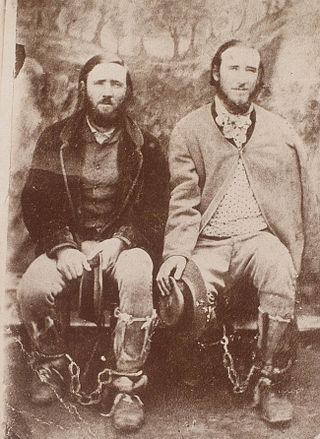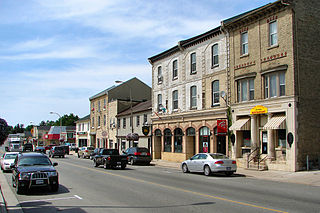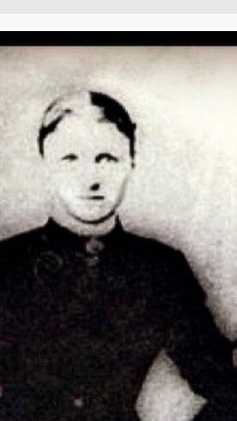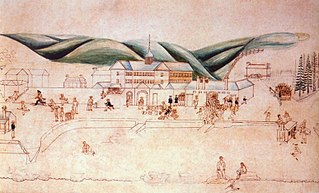
Patrick James Whelan was an Irish-born tailor and suspected Fenian supporter who was executed after the assassination of Irish journalist and politician Thomas D'Arcy McGee in 1868. He maintained his innocence throughout the proceedings. Questions about his guilt continue to be voiced, as his trial was "marred" by political interference, dubious legal procedures, allegations of bribing witnesses and easily discredited testimony.

The "Black" Donnellys were an Irish Catholic immigrant family who settled in Biddulph township, Upper Canada, about 15 km northwest of London, in the 1840s. The family settled on a concession road which became known as the Roman Line due to its high concentration of Irish Catholic immigrants in the predominantly Protestant area. Many Irish Canadians arrived in the 19th century, many fleeing the Great Famine of Ireland (1845-52). The Donnellys' ongoing feuds with local residents culminated in an attack on the family's homestead by a vigilante mob on 4 February 1880, leaving five of the family dead and their farm burned to the ground. No one was convicted of the murders, despite two trials and a reliable eyewitness.

James J. Marcello, also known variously as "Little Jimmy", "Jimmy Light" and as "Jimmy the Man", is a crime boss who was a front boss for the Chicago Outfit criminal organization in the 1980s, 1990s and early 2000s. Organized crime observers identified Marcello as a figurehead during that period while the organization's day-to-day operations actually were run by John "No Nose" DiFronzo, Joseph "Joey the Clown" Lombardo, Joseph "Joe the Builder" Andriacchi and Angelo J. LaPietra.
The Colombo crime family is an Italian American Mafia crime family and is the youngest of the "Five Families" that dominate organized crime activities in New York City within the criminal organization known as the American Mafia. It was during Lucky Luciano's organization of the American Mafia after the Castellammarese War, following the assassinations of "Joe the Boss" Masseria and Salvatore Maranzano, that the gang run by Joseph Profaci became recognized as the Profaci crime family.

Brothers Thomas and John Clarke were Australian bushrangers from the Braidwood district of New South Wales. They committed a series of high-profile crimes which led to the enacting of the Felons' Apprehension Act (1866), a law that introduced the concept of outlawry in the colony and authorised citizens to kill bushrangers on sight. Thomas was proclaimed an outlaw on 31 May 1866.

The Battle of Bossenden Wood took place on 31 May 1838 near Hernhill in Kent; it has been called the last battle on English soil. The battle was fought between a small group of labourers from the Hernhill, Dunkirk, and Boughton area and a detachment of soldiers sent from Canterbury to arrest the marchers' leader, the self-styled Sir William Courtenay, who was actually John Nichols Tom, a Truro maltster who had spent four years in Kent County Lunatic Asylum. Eleven men died in the brief confrontation: Courtenay, eight of his followers and two of those sent to apprehend them. The background context of the battle was the impact of new Poor Law and it has been linked with the Swing riots.
The Pittsburgh crime family, also known as the LaRocca crime family or Pittsburgh Mafia, is an Italian American Mafia crime family based in Pittsburgh, Pennsylvania. The LaRocca family is one of the original 26 mafia families in United States. In 2021, the boss Thomas "Sonny" Ciancutti died, he was also the last known made member of the family.

Lucan Biddulph is an incorporated township in southwestern Ontario, Canada. It was formed on January 1, 1999, by amalgamating the Village of Lucan with Biddulph Township. The township had a population of 4,700 people in the Canada 2016 Census, up 8.3% from 4,388 people in 2011, and covers an area of 169.14 km2 of land within Middlesex County.

Bridget Cleary was an Irish woman who was murdered by her husband in 1895. She was either immolated or her body was set on fire immediately after her death. The husband's stated motive was his belief that she had been abducted by fairies and replaced with a changeling, which he then killed. The gruesome nature of the case prompted extensive press coverage, and the trial was closely followed by newspapers across Ireland.
This is a list of notable overturned convictions in the United States.

The Glenanne gang or Glenanne group was a secret informal alliance of Ulster loyalists who carried out shooting and bombing attacks against Catholics and Irish nationalists in the 1970s, during the Troubles. Most of its attacks took place in the "murder triangle" area of counties Armagh and Tyrone in Northern Ireland. It also launched some attacks elsewhere in Northern Ireland and in the Republic of Ireland. The gang consisted of British soldiers from the Ulster Defence Regiment (UDR), police officers from the Royal Ulster Constabulary (RUC), and members of the Mid-Ulster Brigade of the Ulster Volunteer Force (UVF). Twenty-five British soldiers and police officers were named as purported members of the gang. Details about the group have come from many sources, including the affidavit of former member and RUC officer John Weir; statements by other former members; police, army and court documents; and ballistics evidence linking the same weapons to various attacks. Since 2003, the group's activities have also been investigated by the 2006 Cassel Report, and three reports commissioned by Irish Supreme Court Justice Henry Barron, known as the Barron Reports. A book focusing on the group's activities, Lethal Allies: British Collusion in Ireland, by Anne Cadwallader, was published in 2013. It drew on all the aforementioned sources, as well as Historical Enquiries Team investigations. The book was the basis for the 2019 documentary film Unquiet Graves, directed by Sean Murray.

John Lynch (c. 1812 – 22 April 1842) was an Irish-born Australian serial killer who confessed to the killing of ten people between 1836 and 1842. He is possibly the most prolific individual serial killer in Australian history. Lynch arrived in Australia as a convict, assigned to a farm in the Berrima district. He murdered a fellow assigned convict in 1836 but was acquitted of the charge. After a period in a convict gang he absconded, and by July 1841 he had made his way back to the Berrima district. On two occasions Lynch murdered carriers along the road between Berrima and Camden, stealing their drays and teams. In the latter half of 1841 Lynch murdered the farmer John Mulligan and his family, and took possession of their farm in the Berrima district using the name John Dunleavy. He was convicted in March 1842 of the murder of Kearns Landregan, sentenced to death and executed by hanging in April 1842.

The Cooking Pot Uprising or Cooking Pot Riot was an uprising of convicts led by William Westwood in the penal colony of Norfolk Island, Australia. It occurred on 1 July 1846 in response to the confiscation of convicts' cooking vessels under the orders of the Commandant of the penal settlement, Major Joseph Childs.

Lawrence Cummins, known informally as Larry Cummins, was a bushranger who operated primarily in the districts surrounding the Abercrombie River. In July 1863 he participated in the Mudgee mail robbery led by Fred Lowry and John Foley. Soon afterwards Cummins and his younger brother John carried out several robberies. They were identified and John Cummins was apprehended; he was accidentally shot and killed while being escorted by police constables. Three weeks later Cummins was captured with his associate Lowry, in an encounter with the police which resulted in Lowry’s death. Cummins was sent to Berrima Gaol in late 1863, from where he escaped in November 1866 with another prisoner. From December 1866 to April 1867 Cummins carried out a series of audacious robberies. In April, during an attempted robbery of Webb's store on the Fish River in company with John Foran, he received a wound in the face from birdshot. He was captured soon afterwards and sentenced to thirty years hard labour and sent back to Berrima Gaol.
The trial of Mary Fitzpatrick of November 1882, before Justice Henry Hawkins, was an English murder and robbery case at the York Winter Assizes in the assize courts at York Castle, which drew much attention in contemporary newspapers. It followed the death of 24-year-old glass blower James Richardson, who was last seen alive in the company of rag sorter Mary Fitzpatrick, aged 23, and was next seen dead in the water without his watch and chain. The Coroner's Court returned a verdict of "wilful murder."
Organized crime in the 1880s.










